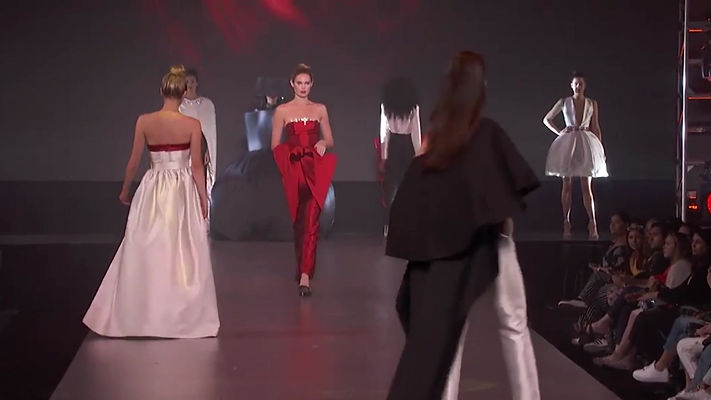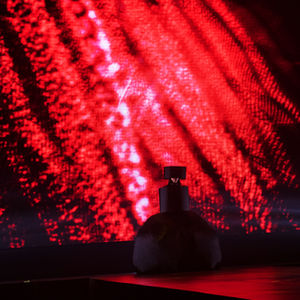
B R O K E N A N G E L
F A L L E N F R O M G R A C E
Broken Angel Fallen From Grace tells the story of an angel who has lost her wings—a story with which many can identify and empathize. The angel—this seemingly invincible higher being—must understand her own identity and relationship with life in order to find her wings again. The story is told semi-retrospectively—the angel begins her narrative reflecting on what has happened to her and as the collection continues, the narrative begins to catch up to the present, where, instead of retelling the story, the angel fully experiences it. Through conflict and catharsis, the angel finally finds her wings and this divine being finally has a human experience.
This collection was predominately inspired by Cristobal Balenciaga’s relationship with the Catholic Church as a gay man—a relationship with which I can deeply relate. The narrative is woven throughout the collection as my angel seeks to find her wings again. Broken Angel Fallen From Grace is a collection that will forever be avant-garde, dramatic, and heartbreakingly honest. Perhaps this is not just the angel’s story—perhaps, this is our story.
PART 001: REVELATION
Revelation depicts our angel in present day. This angel has struggled through trial and tribulation—a divine being that has had a human experience but has become wearied. As the angel walks at a slow pace down the runway, the others—who are representative of different stages of her life—walk past her at a regular speed. This can be interpreted as our angel retrospectively looking at her past, her youth, and her life. The shape of the skirt is significant as it evokes the dome-like structures atop the Vatican. In Revelation, the angel is restricted from sight and movement—therefore, she perhaps represents a modern yet abstract interpretation of living sin. In this collection, the color black is used to represent pain. This angel has suffered and has been made broken by the environment, the systems, and the people around her.

PART 002: RECONCILIATION
Reconciliation depicts the angel at her most innocent. As the angel walks slowly toward the end of the runway in Revelation, Reconciliation is the first look to walk past, memorializing the beginning of the angel's life. It is in this look that the angel exudes purity while maintaining the same shape of the skirt as in her current form. However, juxtaposed with the look prior, Reconciliation evokes a completely different emotion and a completely different response from the onlooker. Adorning this look is a single line of red at the waist which is embellished with crystals. This symbolizes blood—something that denotes being human. However, the purity of the white is not only evident; it is still extremely prominent.

PART 003: REDEMPTION
Redemption signifies a maturity in the angel's life, which is depicted through the contrasting black and white. Because of the maturity, the look resembles the papal regalia and even the shape of the Pope's miter from behind. The embellishments at the waist of the angel in Reconciliation have now been raised to the neckline in Redemption, symbolizing growth. However, what is no longer present is the color red. In its stead is a color that was seen in Revelation. However, it is the white that still covers the black—it is the innocence that covers the pain at this point in the angel's life.

PART 004: REGENERATION
Regeneration is often referred to as being the renewal of all things. In an ironic twist, the pants are adorned with large sculptural pockets on the sides, meant to abstractly represent both a vagina and—from the front—an abstract depiction of ovaries, as a nod to the immaculate conception. In Regeneration, red begins to emerge as a striking color, representing blood shedding—a trait of being human, something that is a natural part of conception and birth, and a depiction of a mortal life.

PART 005: RESURRECTION
Resurrection is both an homage to and a criticism of theology. Along the angel's neckline is a red band; but no longer is this strip of red being hidden as it now spreads across the heart. the angel wears a floor-length skirt lined in red—concealed when not in motion. The question now becomes: by concealing the bloodshed—her mark of humanity, is the angel attempting to hide her loss of innocence and the human parts of her self?

PART 006: RELEASE
Release further represents the conflict between the angel's innocence and lived experiences. In contrast to Redemption, the colors of Release are inverted; it is now the black—which represents pain—that overshadows and hides the white—which represents purity and the angel's innocence. Further, the silhouettes are far different from one another, demonstrating how the angel continues to evolve as she explores her humanity.

PART 007: REBIRTH
Just as the angel struggled with her journey, she has now found herself—once again, a divine being having a human experience. As the music crescendos and as the present day angel in Revelation returns to where her past selves remain, the angel in Rebirth sheds her red cape, finally coming to terms with her human self. Finally, the angel has not just retold her story; she has relived it and has come to better realize her lived experiences. Finally, the angel can embrace the human parts of her existence and has found her wings. Perhaps our angel was never truly broken, or perhaps that brokenness meant that she had finally become human. In this sense, we can better understand that we too can appear to be broken yet can still find our wings. How ironic that being human can be such a divine experience?















